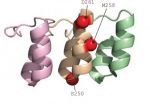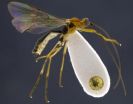(Press-News.org) DURHAM, N.C. -- Ice cream lovers and hot tea drinkers with sensitive teeth could one day have a reason to celebrate a new finding from Duke University researchers. The scientists have found a very small change in a single protein that turns a cold-sensitive receptor into one that senses heat.
Understanding sensation and pain at this level could lead to more specific pain relievers that wouldn't affect the central nervous system, likely producing less severe side effects than existing medications, said Jörg Grandl, Ph.D., an assistant professor of neurobiology in Duke's School of Medicine who led the research team.
Temperature-induced pain, also called thermal pain, occurs when the body's sensory neurons come in contact with temperatures above or below a certain threshold, such as plunging a limb into freezing water.
"We want to understand how either hot or cold temperatures can activate the sensors of hot and cold temperatures in the body," Grandl said.
Previous research has identified transient receptor potential (TRP) ion channels as being highly sensitive to either cold or hot temperatures. TRP ion channels are porous proteins that play a role in initiating electrical signals by controlling the flow of charged ions across the cell membrane.
It's still unclear how temperatures make this happen, but the Grandl team's research reveals that single-letter changes in DNA, called point mutations, are sufficient to make cold-sensitive TRP ion channels become sensitive to hot temperatures instead.
"There is strong interest in understanding temperature-sensitive molecules from a functional perspective because they are promising targets for developing analgesic compounds to treat chronic pain," said Grandl, who is also a member of the Duke Institute for Brain Sciences. "It is something we currently do not treat well. So, one promising strategy is to stop pain where it is initially sensed -- at that first molecule that functions as a sensor of pain."
In a study appearing online early May 8 in the journal Neuron, Grandl's team focused on TRPA1, an ion channel best known as a sensor for pain caused by environmental irritants and pungent chemicals, such as mustard oil, the active compound found in wasabi.
Grandl's colleagues, postdoctoral fellow Sairam Jabba and research technician Raman Goyal, investigated whether single-point mutations could change cold-activated mouse TRPA1 into heat-activated. They formed this hypothesis because, in some other animals, including Drosophila fruit-flies and rattlesnakes, TRPA1 is naturally heat-activated.
To identify these structures, the team created a library of 12,000 mutant clones of the cold-activated mouse TRPA1 ion channel and randomly inserted one or two point mutations into each clone. After placing single clones into the individual slots of a 384-well plate and heating it from 25 degrees Celsius to 45 C in a matter of seconds, they were able to measure the thermal sensitivity of each mutant protein.
This screening pinpointed seven clones that showed strong activation when exposed to heat. Gene sequencing of these clones revealed 12 mutations that could potentially be responsible for changing the mouse TRPA1 from cold-activated to heat-activated. Out of these 12 mutations, Jabba and Goyal identified three mutations powerful enough to individually make that switch in TRPA1.
The mutations all turned out to be located within a single small domain of the ion channel protein known as ankyrin repeat six, indicating this domain plays a role in determining cold or heat activation. Ankyrin repeats are often responsible for managing protein-to-protein interactions, but their precise function in TRPA1 had not been previously known.
Interestingly, these single-point mutations didn't change the ion channels' responses to chemicals, such as mustard oil.
"This was very surprising and it demonstrates that making a single-point mutation produced a profound change in the temperature sensitivity of the protein, but it did not affect the chemical sensitivity," Grandl said. "It shows these mechanisms are to some degree distinct."
Grandl said that taken together, the findings also suggest that the effectiveness of such a small mutation might have been key to a single ancestral ion channel evolving into the wide diversity of temperature-activated ion channels we see today.
INFORMATION:
Funding for this research was provided by the National Institutes of Health grant F32 NS062515-01.
Grandl's co-authors also include Jason O. Sosa- Pagán, Jason Wu and Breanna Kalmeta from Duke University Medical Center; Hans Moldenhauer and Ramon Latorre from Centro Interdisciplinario de Neurosciencias de Vaplaraíso; and Michael Bandell and Ardem Patapoutian from The Scripps Research Institute and the Genomics Institute of the Novartis Research Foundation.
CITATION: "Directionality of temperature-activation in mouse TRPA1 ion channel can be inverted by single-point mutations in ankyrin repeat six," Sairam Jabba, Jörg Grandl et al. Neuron, June 4, 2014.
Small mutation changes brain freeze to hot foot
Shift switches pain sensor from cold-sensitive to hot-sensitive
2014-05-08
ELSE PRESS RELEASES FROM THIS DATE:
Statins given early decrease progression of kidney disease
2014-05-08
AURORA, Colo. (May 8, 2014) - Results from a study by University of Colorado School of Medicine researchers show that pravastatin, a medicine widely used for treatment of high cholesterol, also slows down the growth of kidney cysts in children and young adults with autosomal dominant polycystic kidney disease (ADPKD).
ADPKD is the most common potentially lethal hereditary kidney disease, affecting at least 1 in 1000 people. ADPKD is characterized by progressive kidney enlargement due to cyst growth, which results in loss of kidney function over time. At one time, ADPKD ...
Mummy-making wasps discovered in Ecuador
2014-05-08
Some Ecuadorian tribes were famous for making mummified shrunken heads from the remains of their conquered foes. Field work in the cloud forests of Ecuador by Professor Scott Shaw, University of Wyoming, Laramie, and colleagues, has resulted in the discovery of 24 new species of Aleiodes wasps that mummify caterpillars. The research by Eduardo Shimbori, Universidade Federal de São Carlos, Brazil, and Scott Shaw, was recently published in the open access journal ZooKeys.
Among the 24 new insect species described by Shimbori and Shaw, several were named after famous people ...
NASA sees system 91B lingering over southwestern India
2014-05-08
The tropical low pressure area known as System 91B has been making a slow northerly crawl while sitting inland in southwestern India, and NASA's Terra satellite captured a visible image of the struggling storm that showed half of it is over the Northern Indian Ocean.
NASA's Terra satellite passed over System 91B over southwestern India and the Moderate Resolution Imaging Spectroradiometer (MODIS) instrument captured a visible image on May 8 at 05:40 UTC/1:40 a.m. EDT. The despite having a poorly defined low-level circulation center on infrared imagery, the circulation ...
Experimental antibody shows early promise for treatment of childhood tumor
2014-05-08
Tumors shrank or disappeared and disease progression was temporarily halted in 15 children with advanced neuroblastoma enrolled in a safety study of an experimental antibody produced at St. Jude Children's Research Hospital. Four patients are still alive after more than two-and-a-half years and without additional treatment.
Findings from the Phase I study were published recently online and will appear in the May 10 edition of the Journal of Clinical Oncology. The results prompted St. Jude to expand clinical trials of the monoclonal antibody hu14.18K322A to include patients ...
Wake Forest Baptist finds success with novel lung cancer treatment
2014-05-08
WINSTON-SALEM, N.C. – May 8, 2014 – An old idea of retreating lung tumors with radiation is new again, especially with the technological advances seen in radiation oncology over the last decade.
The Comprehensive Cancer Center of Wake Forest Baptist Medical Center is one of only a handful of cancer centers that is attempting to give lung cancer patients out of treatment options a chance to keep the cancer at bay. For these patients, hope lies in a second course of treatment – repeat radiation. Two complementary papers published back-to-back recently in the journal Radiotherapy ...
Health screening for low-income women under health care reform: Better or worse?
2014-05-08
New Rochelle, NY, May 8, 2014—When Massachusetts enacted its own statewide health insurance reform in 2006, low-income women transitioned from receiving free, federally subsidized screening for breast and cervical cancer and cardiovascular disease risk to an insurance-based payment system. The effects on screening rates in this vulnerable population are explored in Journal of Women's Health, a peer-reviewed publication from Mary Ann Liebert, Inc., publishers. The article is available free on the Journal of Women's Health website at http://online.liebertpub.com/doi/full/10.1089/jwh.2013.4612.
A ...
This FIB doesn't lie: New NIST microscope sees what others can't
2014-05-08
Microscopes don't exactly lie, but their limitations affect the truths they can tell. For example, scanning electron microscopes (SEMs) simply can't see materials that don't conduct electricity very well, and their high energies can actually damage some types of samples.
In an effort to extract a little more truth from the world of nanomaterials and nanostructures, researchers at the National Institute of Standards and Technology (NIST) have built the first low-energy focused ion beam (FIB) microscope that uses a lithium ion source.*
The team's new approach opens up ...
Oregon researchers capture handoff of tracked object between brain hemispheres
2014-05-08
EUGENE, Ore. -- When tracking a moving object, the two halves of the human brain operate much like runners successfully passing a baton during a relay race, says a University of Oregon researcher.
In a study online ahead of print in Current Biology, electroencephalogram (EEG) measured brainwaves from healthy young adults revealed how information about an attended object -- one being watched closely -- moves from one brain hemisphere to the other.
Such handoffs are necessary because the human visual system is contralateral; objects on the left side of space are processed ...
New grasshopper species named after Grammy winner
2014-05-08
A newly discovered grasshopper by University of Central Florida scientists now bears the name of Grammy-award winning singer and activist Ana Lila Downs Sanchez.
The scientists named the new species discovered on the side of a mountain road near Oaxaca, Mexico, after the Mexican-American singer as a nod to her efforts to preserve indigenous culture and penchant for wearing colorful, local costumes as part of her performances.
"It was primarily Paolo's idea to name the grasshopper after the singer" said Derek Woller, one of the authors of the paper referring to colleague ...
Obesity drug failing patients due to lack of education about side-effects
2014-05-08
A new study, published today in the Journal of Health Psychology, found that patients who gained weight 18 months after taking Orlistat attributed their weight-loss failure either to the side effects which have prevented them from sticking to the medication or felt that the medication simply had not worked.
The team from the University of Surrey also found that participants described a series of barriers to weight loss including psychological and physical health issues, relationships and the make-up of their bodies. They also described a number of alternative methods ...
LAST 30 PRESS RELEASES:
ASH 2025: Antibody therapy eradicates traces of multiple myeloma in preliminary trial
ASH 2025: AI uncovers how DNA architecture failures trigger blood cancer
ASH 2025: New study shows that patients can safely receive stem cell transplants from mismatched, unrelated donors
Protective regimen allows successful stem cell transplant even without close genetic match between donor and recipient
Continuous and fixed-duration treatments result in similar outcomes for CLL
Measurable residual disease shows strong potential as an early indicator of survival in patients with acute myeloid leukemia
Chemotherapy and radiation are comparable as pre-transplant conditioning for patients with b-acute lymphoblastic leukemia who have no measurable residual disease
Roughly one-third of families with children being treated for leukemia struggle to pay living expenses
Quality improvement project results in increased screening and treatment for iron deficiency in pregnancy
IV iron improves survival, increases hemoglobin in hospitalized patients with iron-deficiency anemia and an acute infection
Black patients with acute myeloid leukemia are younger at diagnosis and experience poorer survival outcomes than White patients
Emergency departments fall short on delivering timely treatment for sickle cell pain
Study shows no clear evidence of harm from hydroxyurea use during pregnancy
Long-term outlook is positive for most after hematopoietic cell transplant for sickle cell disease
Study offers real-world data on commercial implementation of gene therapies for sickle cell disease and beta thalassemia
Early results suggest exa-cel gene therapy works well in children
NTIDE: Disability employment holds steady after data hiatus
Social lives of viruses affect antiviral resistance
Dose of psilocybin, dash of rabies point to treatment for depression
Helping health care providers navigate social, political, and legal barriers to patient care
Barrow Neurological Institute, University of Calgary study urges “major change” to migraine treatment in Emergency Departments
Using smartphones to improve disaster search and rescue
Robust new photocatalyst paves the way for cleaner hydrogen peroxide production and greener chemical manufacturing
Ultrafast material captures toxic PFAS at record speed and capacity
Plant phenolic acids supercharge old antibiotics against multidrug resistant E. coli
UNC-Chapel Hill study shows AI can dramatically speed up digitizing natural history collections
OYE Therapeutics closes $5M convertible note round, advancing toward clinical development
Membrane ‘neighborhood’ helps transporter protein regulate cell signaling
Naval aviator turned NPS doctoral student earns national recognition for applied quantum research
Astronomers watch stars explode in real time through new images
[Press-News.org] Small mutation changes brain freeze to hot footShift switches pain sensor from cold-sensitive to hot-sensitive






